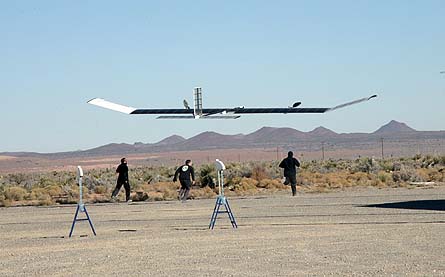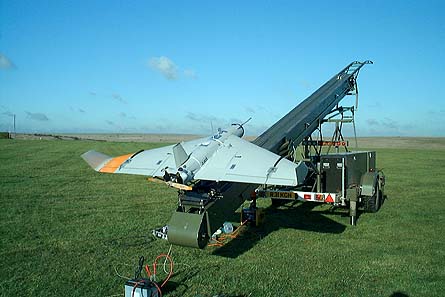By Craig Hoyle in Farnborough
UK research and technology house Qinetiq will use this year’s Farnborough air show to highlight its recent achievements in the unmanned air vehicle sector, which include successful risk-reduction trials of its lightweight Zephyr high-altitude, long-endurance (HALE) platform, expanded support for the ParcAberporth UAV centre of excellence and involvement in the Astraea airspace integration initiative.
|
|---|
| A Zephyr HALE UAV flew for 6h after taking off from the White Sands missile range in New Mexico |
Qinetiq will also exhibit a model of its latest Zephyr variant in the same configuration as the two air vehicles that completed successful proving flights at the White Sands missile test range in New Mexico last December. Dubbed air vehicles 5.1 and 5.2, they logged flights lasting 4.5h and 6h respectively and reached an altitude of 27,000ft (8,230m). However, the company believes a self-sustaining development of the Zephyr could extend mission endurance to around three months, with the aircraft operating at altitudes around 60,000ft – above the influence of the jetstream, adverse weather and commercial air traffic. The plan is for a Zephyr to fly using solar power during daylight hours while also storing sufficient energy in its rechargeable battery to power it through the night without falling below 50,000ft. While a rechargeable battery is still in development and has yet to undergo flight testing, the platform’s current solar arrays are capable of generating around 1kW despite an efficiency rating of less than 10%, says Qinetiq’s Zephyr business development director Paul Davey.
|
|---|
| TopSat can deliver imagery to support disaster relief operations |
Solar array
During the 2005 test flights, two sub-30kg (66lb) UAVs were flown, one using battery power alone and the other, which completed the longer sortie, drawing power from both a battery and the solar arrays on the aircraft’s 12m-span wing. Constructed using carbonfibre and a Mylar coating, and with removable fuselage and tail sections, the twin electric-motor-powered Zephyr could be used to conduct persistent surveillance, maintaining around 12kt (22km/h) and using GPS waypoint navigation to remain on-station. The air vehicle currently needs to sustain an angle of attack of around 6° during flight.
Although its lightweight structure and slow speed will restrict the air vehicle’s payload, Davey says its affordability and ease of operation are important characteristics for its future business prospects. “We will try to do one or two jobs very credibly,” he says, citing surveillance and communications relay tasks as possible contenders. The Zephyr system is not designed to compete with satellites, but could be used in combination with low-cost spacecraft such as the Qinetiq-designed TopSat.
A 40%-scale model of the Zephyr 5 vehicle was flown at lower levels in advance of the US trials to replicate the performance characteristics of its larger stable-mates at altitude. In the recent trials, the two air vehicles were hand-launched by three people, completed their sorties and landed without suffering damage despite their lack of an undercarriage or the use of a runway. The vehicles required no maintenance or logistics support following the flights, only visual inspection.
Night flights
Future flight trials are expected to include an overnight mission, for which the Zephyr’s solar array will have to store enough energy to keep the vehicle airborne through the hours of darkness. Funded using a mixture of company money and allocations from the UK Ministry of Defence, previous tests have included flights at the Woomera test range in South Australia. The MoD has shown some interest in the design for military applications, believed to include persistent reconnaissance and communications relay duties. Although 2005 test flights involved an unmanned system using its own automated flight-control software, the flight still required input from a pilot, navigator and flight engineer for qualification purposes, says Zephyr designer Chris Kelleher.
Qinetiq has so far manufactured between seven and nine Zephyrs across several variants, with the latest featuring a removable payload pod that can be screwed on to the aircraft’s nose to carry a lightweight electro-optical sensor or communication relay payload. The Zephyr was initially intended to form part of the Qinetiq 1 manned balloon altitude record attempt, with a tethered version of the UAV expected to achieve an altitude of 132,000ft. However, although production processes have improved over the life of the programme, Davey says: “We’re always looking to shave off another 10g [0.35oz] here or there.” The current air vehicle is capable of withstanding a gust loading of 5g, Qinetiq says.
|
|---|
| Qinetiq is to provide support to UAV operations at ParcAberporth in Wales |
A civil version of the Zephyr, dubbed Mercator, has been built and is awaiting delivery to Belgium’s Flemish Institute for Technical Research but the project has been delayed while the Belgian authorities strive to come up with a means of certificating the experimental aircraft for HALE missions in Belgian airspace. The Mercator design, to be used as part of a remote-sensing project, closely resembles the Zephyr 5 but has an increased wing span of 16m. Qinetiq intends to ship the Mercator air vehicle to its Belgian arm Verhaert soon, ahead of delivery to its customer, which intends to conduct an initial 72h proving flight with the vehicle.
Davey sees a bright future for unmanned platforms such as the Zephyr and Mercator, which could be deployed in response to natural disasters. “If you have a disaster area you could put half a dozen Mercators up at 60,000ft and provide a basic rebroadcast capability,” he says. From that altitude, the UAV would be able to see 400km (215nm) in any direction, he adds. Qinetiq believes its HALE design could also be equipped with lightweight sensors in its wing to further boost its operational capabilities.
Observer cleared
Qinetiq’s evaluation work with UAVs is not restricted to the Zephyr series of air vehicles. The company has recently secured clearance to place its Observer demonstrator air vehicle back on the UK military register to support future trials and sensor integration. The UK MoD earlier this year asked Qinetiq to contribute a UAV system to support a Combined Qualified Weapons Instructor (CQWI) course at RAF Leuchars in Scotland, but bad weather during a May trials period prevented the Observer platform from participating in the manoeuvres, which also included around 50 manned strike and reconnaissance aircraft.
|
|---|
| The Observer UAV is optimised for single operator control |
The UK’s Air Warfare Centre has invited UAV manufacturers to supply systems to support such operations in the future, but is dependent on industry covering their own participation costs. Qinetiq says the Observer could take part in the next CQWI course in November, but weather conditions could again delay its participation in the exercise until next year. The company now has three air vehicles available: two equipped with electro-optical payloads and the other carrying an infrared sensor.
Nigel Mills, Qinetiq’s technical director – air, says military users continue to take the lead in the UAV sector, but their activities are primarily conducted through the use of test ranges and special permits to fly, or under combat conditions. With the commercial sector seemingly more reluctant to embrace unmanned aviation, he says: “The key issue to justify investment is the market.” Mills believes the UK’s initially three-year Astraea initiative is a key advance, and highlights his firm’s involvement in the scheme through technical area, including autonomy and the development of lightweight sensors.
Qinetiq’s previous work on autonomous systems is expected to continue into involvement in a new unmanned combat air vehicle (UCAV) technology demonstration programme to be headed by BAE Systems and now awaiting programme launch by the MoD. Mills believes Qinetiq’s work on passive millimetre-wave sensors capable of seeing through clouds – and into communications relays, miniature synthetic-aperture radars and lightweight electro-optical devices – could all lead to lucrative business in a future, expanded UAV sector.
Precision landing systems – such as that already demonstrated using the company’s VAAC Harrier trials aircraft that is now supporting the development of flight-control laws for Lockheed Martin’s F-35B Joint Strike Fighter – are also applicable for use by UAVs, he says.
Qinetiq last month entered a partnership agreement with West Wales airport – home to the ParcAberporth development – to provide technical and support services to UAV operators at the site. To allow users to benefit from the experience of earlier trial and certification activities, the West Wales UAV Centre will charge from just “tens of pounds” to use its expertise, says Andrew Chadwick, Qinetiq’s business development manager for UAV services. Work to be offered by the new venture includes “the development of safety cases, system design advice and flying supervision”, the company says. A recent example saw a demonstration of the NitroHawk unmanned helicopter to police officials.
The new centre’s operators hope to expand such activities by securing a permanent sector of airspace around the site for UAV trials. The facility already has a temporary restricted area within 8km (5 miles) of the airport, but centre officials have asked the UK Civil Aviation Authority to make the segregation permanent. With the West Wales airport site and Qinetiq’s neighbouring Aberporth test range likely to play important parts in the later stages of the Astraea project, the elimination of the current three-month approvals process to fly unmanned aircraft from ParcAberporth will ease the process of acquiring permission to fly UAVs in non-segregated airspace on a routine basis. The joint application is expected to be approved by year-end, says Chadwick.
In an intriguing development, Qinetiq has also revealed that it plans to return its XRAE-1 unmanned aircraft to flight later this year after a gap of around a decade. In addition to its Observer demonstrator, the legacy UAV could serve as a testbed for new payloads, the company says. The XRAE design has a 2m wingspan, weighs around 20kg and is being eyed as a potential platform for civil test applications. Meanwhile, the company intends to use its Observer airframes as “sensor trucks” to assist in the development of military operations. However, repeating Mills’s concerns over the slow pace of growth in the commercial UAV business, Chadwick notes: “There is a risk in this – we are trusting a market that doesn’t exist yet.” However, he believes demand for UAVs will grow such that “the market will push the regulators”.
With an eye to future production, Qinetiq believes a strong market exists for a system such as the Zephyr and the commercial Mercator. With BAE likely to lead efforts to produce a UCAV and, potentially, stealthy unmanned surveillance aircraft for the UK armed forces over the decades to come, Qinetiq is also eyeing a potential market niche in the less-than-20kg product range, the company says.
In addition to its certification clearance work now taking place at ParcAberporth, Qinetiq is expanding its efforts to train current and future UAV operators. Focusing on trials and evaluation work, the first unmanned systems course to be managed by its Empire Test Pilots’ School at Boscombe Down in Wiltshire concluded recently, having involved 14 delegates from the UK MoD or from within the company organisation. The course involved the simulated use of an Observer air vehicle and an opportunity to witness live operations of the British Army’s Phoenix battlefield UAV system.
Source: Flight International




















